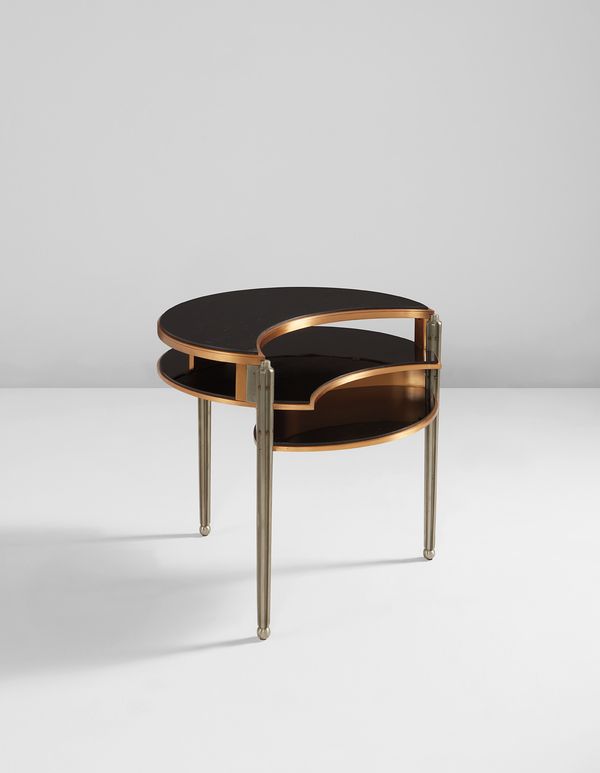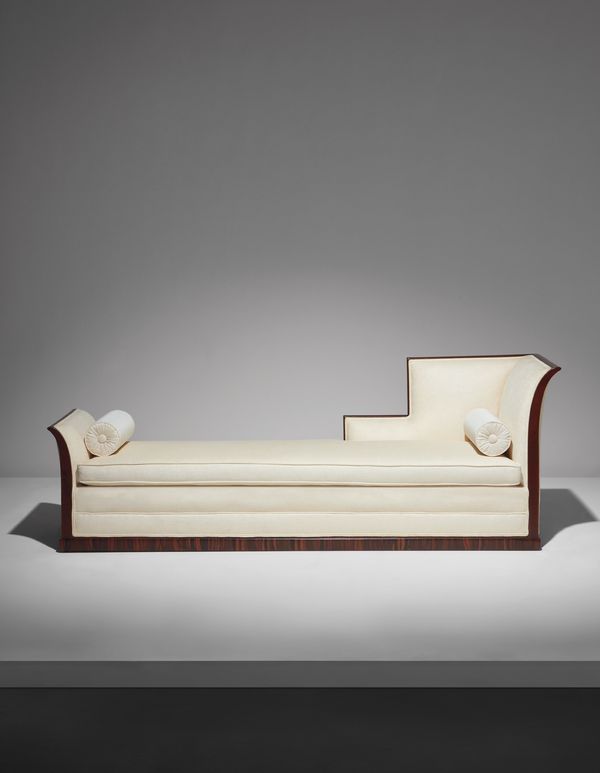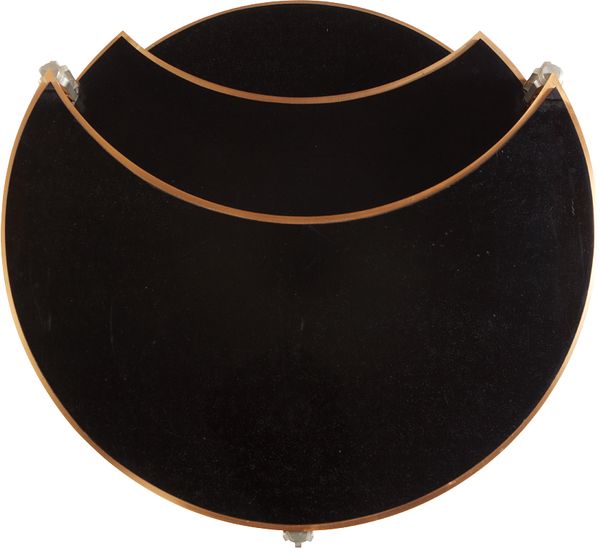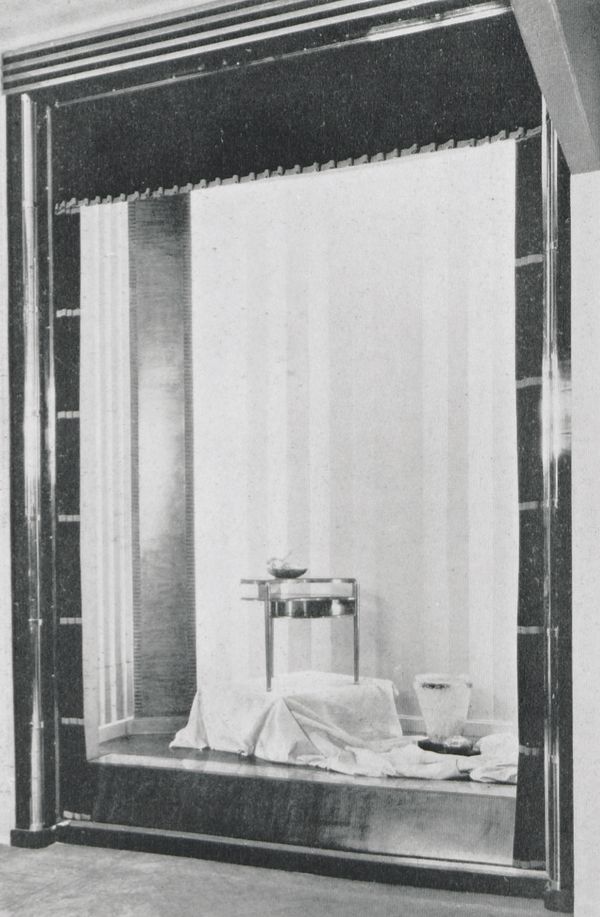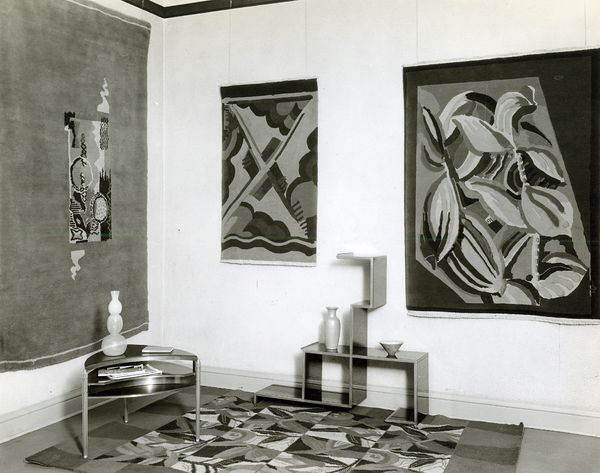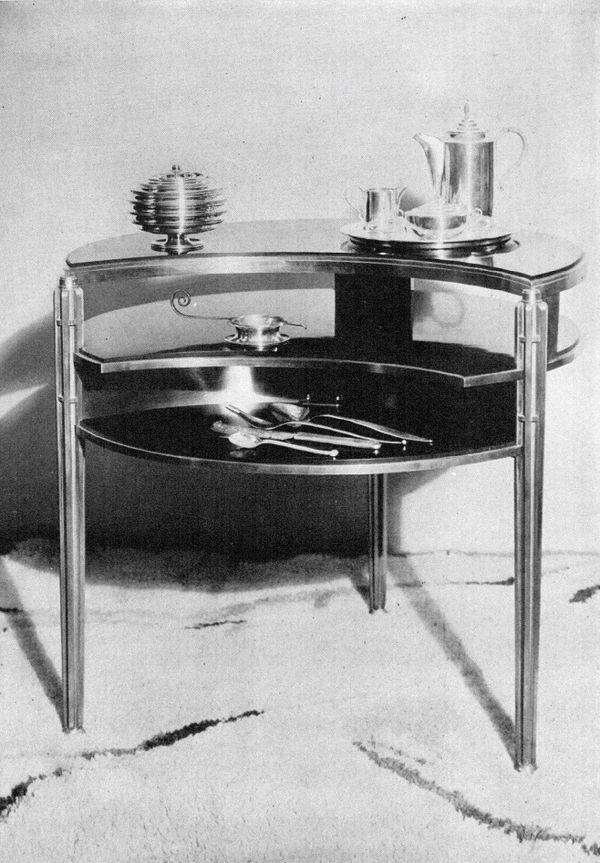Eugene Schoen Important and unique cocktail table, circa 1929
Over the past two decades, there has been a significant increase in scholarship on American design from the 1920s and 1930s, as blockbuster museum surveys have been supplemented with monographs on many of the key players, including Paul Frankl, Frederick Kiesler, Ilonka Karasz and Kem Weber. Academia has been focused on the influence of Austrian and German design on the Americans, many of whom were European immigrants trained in Vienna and Berlin, as well the stylistic tendencies of what is frequently referred to as the Machine Age, with its celebration of speed, industry and the metropolis. There has been strong coverage of the mass-produced metalwork of the era, especially the beverage services which poured the cocktails of Prohibition and the Jazz Age.
What has been somewhat overlooked, despite being mentioned in every introduction to the period, is the influence of the 1925 International Exhibition of Modern Decorative and Industrial Arts in Paris on the Americans. The natural tendency has been to focus on the French masters, many of whom were exhibited at the time in American museums, but the furniture designs of the New York-born Eugene Schoen, which epitomize the "moderne" style (a contemporaneous term used by the Americans to describe their nascent trend, cribbed from the French title of the 1925 exhibition), deserve a closer look. The appearance here at auction of a Schoen masterwork — a tiered low table previously seen in three distinct period photographs — gives us an opportunity to reevaluate a designer who was a central figure in American museum exhibitions of the late 1920s.
Eugene Schoen's furniture was most frequently produced by the New York cabinetmakers Schmieg, Hungate and Kotzian, who fulfilled Schoen's vow of producing "one of a kind" pieces comparable in quality, finesse and sophistication to works produced in Paris. The firm's brand appears on furnishings from the most important residential commissions of the era: Donald Deskey's dining suite in the Mandel House; Marcel Breuer's modernist designs for the Frank House; and Schoen's most important project, the twenty-five room Morris and Gwendolyn Cafritz mansion in Washington, D.C., completed in 1937-38, which included his signature demilune chair in bleached hornbeam and white leather (examples of which are in the collections of The Metropolitan Museum of Art and the Yale University Art Gallery), the only Schoen design to be used in multiple commissions.
"Seriousness, and a thorough knowledge of what has gone before are the essential bases of new creations in decoration," proclaimed Schoen in a 1928 article, and a survey of archival photos gifted by Lee Schoen (who joined his father's firm in 1929) to The Metropolitan Museum of Art and of corresponding pieces in museums reveals an œuvre of elaborate veneers and exotic woods, which only a sophisticated firm trained in European techniques could produce. Several pieces, including a checkerboard cabinet in the Milwaukee Art Museum and a dining chair in the Museum of Fine Arts, Springfield, are distinctly Austrian in their inspiration, referencing the designs of Josef Hoffmann. But the majority of Schoen's pieces produced by the New York cabinetmakers, including a horizontal drop-front desk in the Brooklyn Museum, a sideboard in the Cooper Hewitt Museum and a rather ponderous buffet in the Philadelphia Museum of Art (which was proclaimed by the museum's curator in 1929 as "the finest piece of furniture made by an American craftsman in the modern manner"), are French in their inspiration. And several of Schoen's most elegant designs, including a dining table illustrated in the Met's archives and the daybed in Macassar ebony which precedes this tiered table in our December Evening Sale, clearly “earned him the sobriquet of 'the American Ruhlmann,'” in the words of the curator R. Craig Miller.
Eugene Schoen Daybed, circa 1930
However, the most famous piece of Schoen furniture, a dramatic étagère in the skyscraper style acquired by Miller for The Metropolitan Museum of Art in 1984 from Schoen's family, and exhibited in the two most important twenty-first century museum retrospectives (the Met's American Modern, 1925-1940: Designs for a New Age and the Victoria & Albert Museum's Art Deco 1910-1939, stands apart from the majority of Schoen's designs, and its cabinetmaker has never been identified. A composition in black and gold, the chestnut frame covered in Bakelite and trimmed in bronze, this stunning display piece epitomizes a new direction in American furniture, an expression of modernity influenced by the Manhattan skyline and incorporating the latest in synthetic materials. And yet it was not exhibited by Schoen in The Architect and the Industrial Arts, the landmark Met exhibition of 1929. That honor goes to its partner in modernity and materials, the present triple-tiered table.
A composition in black and gold...this stunning display piece epitomizes a new direction in American furniture, an expression of modernity influenced by the Manhattan skyline and incorporating the latest in synthetic materials.
The Bakelite-surfaced tiers of the present table are framed in bronze, creating the same brilliant black and gold contrast seen in the étagère. The three graduating crescent-form levels imitate the shifting of gears or camera shutters. The fluted nickel-plated legs are a clear Ruhlmann reference, but the overall effect is one of American modernity, and the underlying purpose of the design is most likely for a unique American entertainment of the Prohibition era, the Manhattan cocktail party. The surfaces of many tables in the 1929 Met exhibition were covered in Bakelite, Formica, or black glass, which not only represented modernity but were also easy to wipe down after a spilled drink. A new form, the low cocktail table, was being introduced by Gilbert Rohde and Donald Deskey in other 1929 exhibitions, once again featuring surfaces of Vitrolite and glass. Schoen was one of the members of the Met exhibition's co-operating committee, which also included Raymond Hood, Ely Jacques Kahn and Eliel Saarinen. His specific contribution was two separate displays: "Show Window and Sales Alcove," and "Child’s Nursery and Bedroom."
It was in the show window that the present table was displayed. In his brief description for the exhibition catalogue, Schoen focused on the use of sophisticated lighting schemes which were timed and enhanced through reflectors and colored lamps to "[enable] the merchant to show his goods in a dynamic way, as changing interest plays an important part in display." The accompanying image documents that the table was the main beneficiary of these special effects.
The table exhibited at The Metropolitan Museum of Art, 1929. Image provided by The Metropolitan Museum of Art, New York, Thomas J. Watson Library
The table exhibited at the Newark Museum, 1930. Collection of the Newark Museum Archives
Highlighting the significant role that American producers played in this era, the catalogue further records every manufacturer and vendor responsible for the exhibition elements. It is here where identifying the actual maker of the table gets complicated. In the 1929 Met catalogue, the furniture in both the show window and sales alcove is captioned as being "designed by Eugene Schoen and executed by Schmieg-Hungate & Kotzian, Inc., New York." And without a doubt, the elaborately veneered desk and accompanying chair designed by Schoen which appear in the sales alcove are clearly Schoen designs that would be produced by the firm. In the caption accompanying the show window, the metal frame of the window front is listed as being produced by William O. Chapman, Inc., New York. This is noteworthy because in the same year a trade publication known as The Metal Arts published a studio photograph of the present table and other examples of Schoen's metal furnishings, each with the caption "executed by the Wm. O. Chapman Company."
This photograph would be reproduced again in Paul Frankl's seminal Form and Reform in 1930, minus any mention of manufacturer. Research into the corporate records of the William O. Chapman Company which were published in the Iron Trade Review lists a Valentine Kromm as an employee of the firm. Kromm would later appear as the producer of Schoen's purely modernist nickel and glass table for the Center Theater at Rockefeller Center in 1932 (sold at Christie's, New York, in 2000). Schoen also worked with another metals firm, Segar Studios, Inc., of New York, which produced the metal furniture for the child's bedroom of the Met exhibition, the designs serving as the precedents for the Center Theater commission. Therefore, based on the compelling article in The Metal Artsand the fact that neither the present table nor the étagère are stamped with Schmieg, Hungate and Kotzian's brand, it seems highly probable that these two major works, similar in both style and materials, were executed by the heretofore obscure William O. Chapman Company.
The table pictured in Paul Frankl, Form and Reform: Practical Handbook of Modern Interiors, 1930
In 1930, the Newark Museum presented one of its ongoing historical surveys of the decorative arts. Rugs and Floor Coverings exhibited textiles from Antiquity to the present day. In the museum's records of the exhibition, correspondence is preserved detailing that Eugene Schoen and Donald Deskey were asked to loan modernist carpets from their showrooms and decorate the museum's displays with their own furniture designs. In Schoen's case, he lent French Art Deco textiles which he probably had for sale in his East 60th Street showroom, and two distinctly modern pieces of furniture: The Met's étagère, and the present tiered table. What seems clear is that Schoen prized these two pieces as examples of modernity, and regarded them as variations of the same theme.
Now, nearly ninety years after its last appearance in a museum exhibition, the table will once again be on view at Phillips where collectors and scholars can finally appreciate this unique masterwork in person.
In addition to the references illustrating the present lot, the author, James Zemaitis, is indebted to the early exhibition catalogue authored by Karen Davies, 'At Home in Manhattan: Modern Decorative Arts 1925 to the Depression' (Yale University Art Gallery, 1983); and Paul Donzella and Eric Kohler, 'Eugene Schoen Furniture from the Morris & Gwendolyn Cafritz Estate', (Donzella Ltd., New York, 2008).

